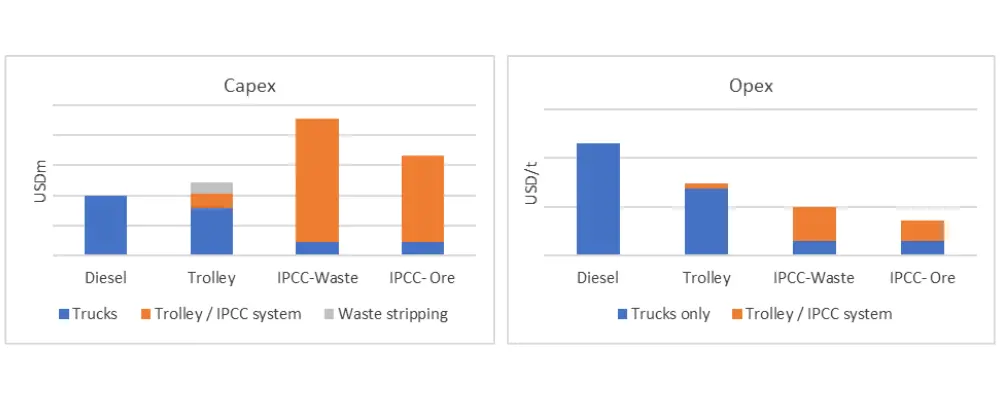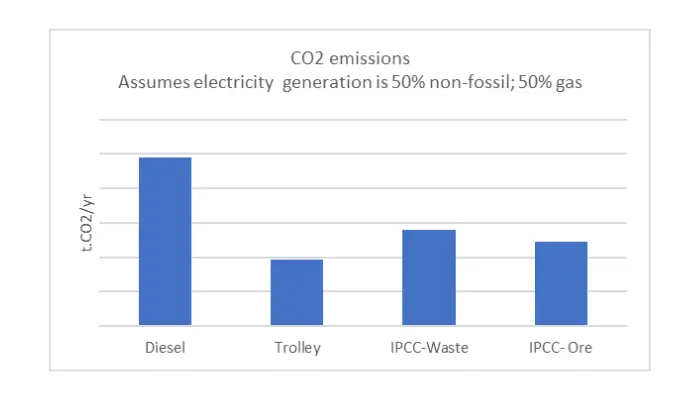Diesel haulage is often the mine's largest source of greenhouse gas emissions with a typical 240t truck using ~ 800,000 litres of diesel per year emitting ~2,300 t.CO2/year. Several principal options exist to reduce these emissions including:
- Switching to renewable or biodiesel. Renewable diesel is a fuel made from fats and oils, such as soybean oil or rapeseed oil, and is processed to be chemically the same as petroleum diesel, whilst biodiesel is a mono-alkyl ester produced via transesterification and is approved for blending with petroleum diesel. Renewable diesel is of interest as it enables the mine to utilise its current truck fleet and does not require any changes in mine layout or sequence, though supply is limited and there are questions about the environmental impact if crops are being grown specifically as a feedstock for making fuel.
- Using hydrogen fuel cells where hydrogen is produced from either electrolysis (green hydrogen), natural gas with (blue) or without (grey) carbon capture, super-heated steam associated with nuclear power stations (pink) or methane pyrolysis (turquoise). Last year, Anglo American successfully operated a pilot hydrogen fuel cell truck at is Mogalakwena mine and plan to convert or replace their current haul-truck fleet over the coming years. Producing hydrogen by electrolysis is currently less efficient than directly using electricity through trolley assist but does not require any changes in mine layout or sequence.
- Switching to battery powered trucks where the batteries are charged from mainly renewable sources. At present, only underground battery trucks are in commercial production whilst the major truck suppliers are developing pilot trucks with the intention of having commercial versions available from 2027. This said, there is no reason why underground battery trucks could not be used above ground where 50-60t trucks are required.
- Installing a trolley-assist system to provide electrical power directly from overhead cables to the wheel motors for the energy-intensive uphill haul. Trolley assist systems are proven technologies and have been installed in more than 15 mines world-wide, from near-Arctic to desert environments.
- Installing a crusher and conveyor system to haul ore and/or waste to either the processing plant or waste dump. These can be either conventional belts, cable supported or high-angle with crushers placed either within the pit or on the pit-rim.
SRK notes that there is increasing interest in the electrification of open pit transportation and this article will focus on some of the challenges and benefits of the existing technologies; i.e. trolley assist and crushing & conveying.
Trolley Assist
Electric-drive trucks powered by a trolley line can drive uphill 60-80% faster than when powered by their diesel engine because their wheel motors are typically over-sized relative to the engine to ensure that the truck can brake safely and quickly when fully loaded. Consequently, not only do trolley-trucks reduce diesel consumption from ~400 litres per hour for a 220t truck to ~30 litres per hour whilst travelling uphill loaded on trolley, they can also drive uphill at ~20-22 kph vs 12 kph on an 10% ramp, thereby reducing cycle times.
This reduction in cycle time reduces the number of trucks required with the savings in truck purchases nearly offsetting the capital costs associated with installing the trolley line. Further advantages of trolley assist are that trucks hauling ore and waste can use the system simultaneously and trucks can join the line at any point. Trolley systems will also facilitate the transition to battery trucks by taking responsibility for the “heavy lifting” and potentially providing a top-up charge.
So, what’s the catch? Besides the fact that the ramps often need to be much wider with a third lane added as the haul trucks are now travelling much faster than other equipment (graders, dozers, etc) and some extra width for the trolley line, the principal constraints are the impact on the mine design and the mining sequence caused by adding such semi-fixed infrastructure. Specifically:
- Ramps should ideally be straight or with gentle curves as it is difficult, though not impossible, to tension cables on a curve. Therefore, trolley systems are best suited for large, elongated pits, pits with switch-backs, or on waste dumps.
- It is not possible to mine above a trolley line and therefore the trolley line needs to be relocated before mining the next cut-back. This is not always possible or may require a change from the “optimum” mining sequence, reducing the value of installing a trolley system.
- The trucks using the trolley line should be the same size and therefore if the ore trucks are much smaller than the waste trucks, these will not benefit. Whilst there is some research into using trolley lines placed vertically on poles, these are not yet in common use.
- Wider ramps require more waste to be stripped, adding to mining costs, although for large pits these costs may not be material.
- The additional power demand may require additional power lines to the site and discussions with the grid supplier about constructing additional capacity which may affect the timing of the installation of such systems.
Crushing and conveying systems
Transporting rock by conveyor is inherently more efficient as trucks also need to move a significant amount of steel and rubber (the payload of a typical off-highway truck is only ~55% of the GVW requiring nearly as much energy to move the truck as the payload), whilst the conveyor “just” needs to overcome friction. If ore is transported, the crushing effort would happen anyway, although for waste the crushing effort is additional. The principal advantage of crushing and conveying systems is the lower OPEX due to the inherent efficiencies, although there can also be benefits if the material needs to traverse uneven terrain or pass through a hillside rather than go over it.
Depending on the crusher required, a crushing and conveying system is a significant, up-front capital cost. This said, the principal challenges defining whether this solution is appropriate or not are:
- Identifying a suitable location for the crusher. This needs to consider the future mining sequence as it is not possible to mine above the conveyor and therefore any further pit expansions require the system to be relocated first. Also, the system needs to be located so that it can be fed continuously over its life without requiring trucks to drive downhill loaded to the crusher.
- Sizing the system so that it is used efficiently, as any peaks in production require hauling material from depth using trucks which may impact on production, whilst any troughs are opportunities lost.
- For ore, having a single crusher in the pit with no stockpiles may affect blending strategies. If it is possible to campaign ore to the crusher, then it is possible to have a conveyor distribution system outside the pit to direct ore to different destinations or stockpiles, although campaigning may limit flexibility of mining operations if other shovels have to wait their turn.
- Having options for when the system is not operating. Typically, crushing and conveying systems operate for ~6,000 hours per year whilst operations are busy ~7,000-7,500 hours per year. Sometimes the reasons for no operation are shared (e.g. production shutdown for blasting) although often the discrepancy is due to the mis-match between batch (i.e. truck) and continuous (i.e. conveyor) systems with the crushing-conveyor system waiting for feed. When the crushing-conveyor system is down due to mechanical reasons or for the relocation of the stacker for a waste system, then all material needs to be transported to surface by truck which will reduce productivity for a short time as there are no longer enough trucks. This can be modelled and appropriate solutions found to ameliorate the impact.
Cost-benefit analysis
So why do we want to look at these systems when there are such complications. The following charts show the relative costs and emissions for a typical project moving 40 Mtpa with a 200m lift. This analysis does not consider carbon taxes or shadow carbon charges which can be significant. This analysis highlights the attractiveness of both trolley assist and crushing and conveying systems in terms of reducing emissions and operating costs.


